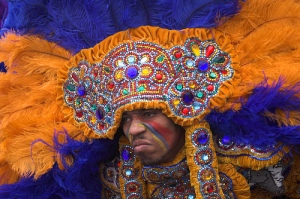The Mardi Gras Indians
This is called Confrontation by a photographer named dsb_nola. You can find him/her at Flickr.com.
The Mardi Gras Indians used to practice parading down Magnolia Street, past the corner of my grandmother’s house. They are the pride of the black community, in my view, although in the beginning of the last century, it wasn’t always such. Historically, tribes began as early as 1837, and possibly membership accelerated after Buffalo Bill’s “Wild West Show” visited New Orleans. Their marches were sometimes punctuated by “the bucket of blood,” when there was an opportunity for some guys to get revenge on each other using knives and fists. They would end up in the hospital or “the dead house.”
Now they compete style-wise. These are black men who were proud of their mixed heritage (Indian and black; black and Creole), of their artistry in making these beautiful feathered outfits, and of being men who made a life for themselves and for their families. I was always amazed that they were men who didn’t care that they were sewing, a mostly female art. I knew there was a certain class of black men who were tailors, but these men were not always tailors. They were men who did heavy work with their hands: longshoremen, construction workers, truckers. They spent months, putting together these costumes, often at great expense and personal sacrifice. Yet every year, they were a wonder, blooming at Mardi Gras or on St. Joseph’s Day. They are always a great wonder, even after Katrina.













Thanks for being active in the Mardi Gras Indian history, oh and by the way: that picture you got up there is me, lol…
LikeLike
Well done, bro. Hope you don’t mind, but you do look rather fierce there. Can you tell me to which tribe do you belong?
LikeLike